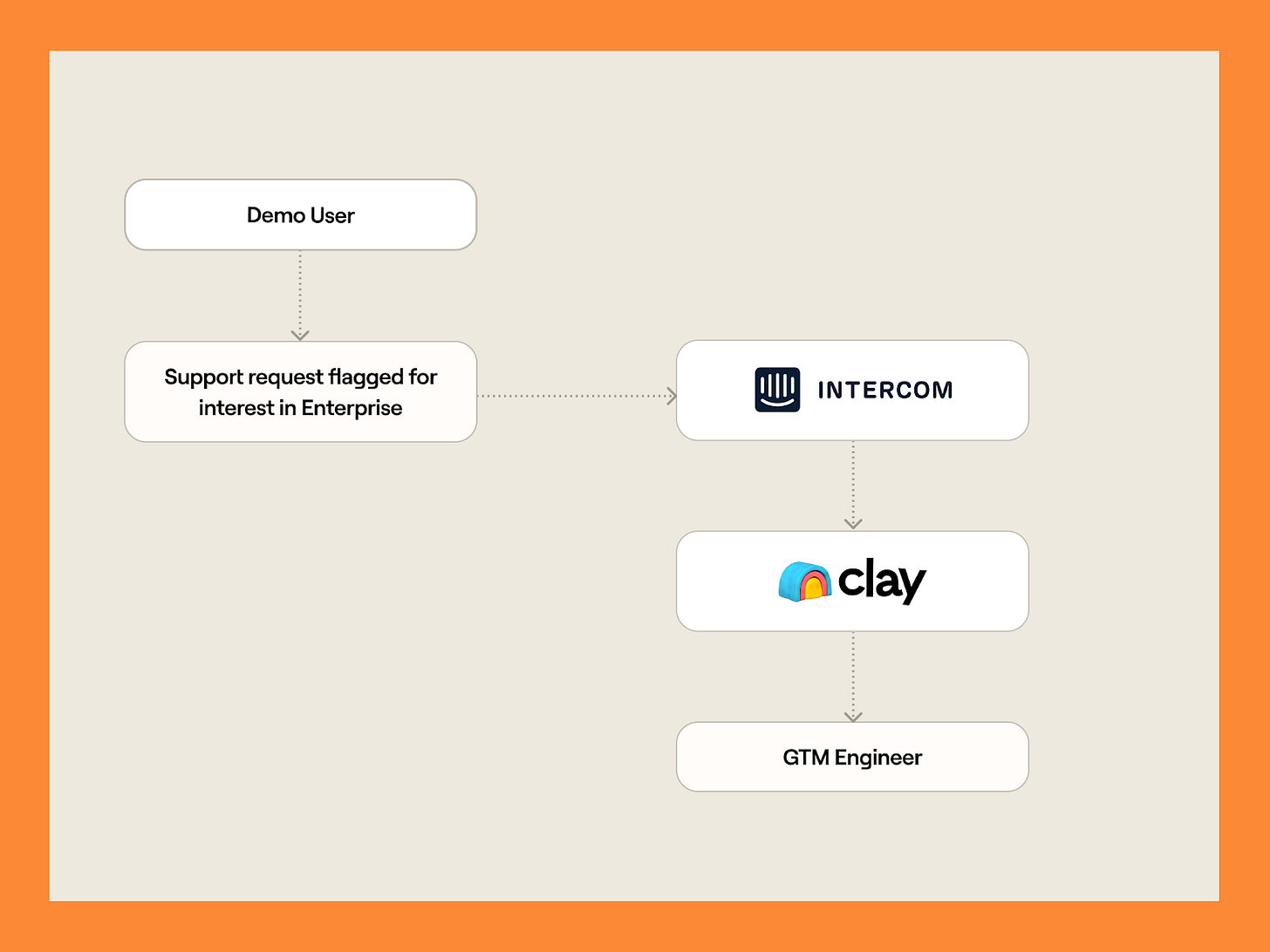From our problems to your solutions: inside Clay’s GTM engineering lab
Four internal plays that you can copy today
A few years ago, when our GTM team started building Clay’s revenue engines using AI tools and automation, we began calling them GTM engineers. In the last two years, companies like Cursor, Lovable, and Webflow have adopted this job role, and we’re seeing more than 100 listings using the title go live every month.
Two weeks ago, our first newsletter broke down what GTM engineers do and why they’re ripe for the moment. This week, we're opening up Clay's GTM engineering lab to show how we use state changes to trigger revenue plays—and how every problem we solve internally becomes a feature our customers rely on.
From internal solutions to customer success
Clay is the default tool for GTM engineers, and what we pilot internally often turns into powerful customer use cases. We simultaneously learn from what our customers want and what we need to build.
We often go from internal problem → solution → beloved customer feature:
Our sales team wanted automated pre-meeting notes → Notion integration
We needed personalized landing pages → Webflow integration
We needed to convert more trial users → automated trial conversion emails
Inbound response time was killing conversions → automated routing and messaging
This approach—turning our own needs into customer solutions—runs on four core principles.
The four principles of GTM engineering
Four tenets guide GTM engineering at Clay.
1. The user journey is a state machine. Customers move through stages or “states” as a deal progresses. A GTME’s job is to understand what triggers those state changes and how to activate them. Approximating a customer’s state tells us how to develop our relationship.
2. Go-to-market is a learning exercise. The market is a moving target, with a stream of new entrants and constant changes. No tactic lasts forever: experimentation is necessary.
3. Deliberate design unlocks freedom. Well designed systems let you iterate fast. We build modularly to avoid vendor lock-in and mix-and-match capabilities.
4. Good GTME teams are a force multiplier. We help GTM teams scale their work and ideas effectively. One seller’s great idea should always become an entire team’s superpower.
These principles ladder up into the foundational belief that any GTM function needs to be an adaptable, experimental process: strong enough to run smoothly and nimble enough to shift gears. That’s reflected both in how we built Clay as a product and how we use Clay as a GTM engineering team.
The first principle—treating the user journey as a state machine—is where everything starts. Because if you can identify when users change states, you can build systems to respond automatically.
All problems are data problems
These principles come to life through how we approach every GTME challenge at Clay. Each GTME problem starts with data. The user journey is a state machine, and we use Clay to identify the right signals to know when and how a user is transitioning between states. We've built our entire GTM motion around identifying these state changes and automating our response.
Let's dive into four example plays built around state changes:
Play #1: Job listings as market intelligence. We'll show you how to turn job postings into qualified pipeline by identifying companies ready for GTM transformation.
Play #2: Converting trial users at scale. Here's how we transform free users into enterprise accounts with automated, personalized outreach.
Play #3: Seamless sales-to-success handoffs. We'll walk through automating the context transfer between sales and growth teams to prevent churn.
Play #4: Mining support conversations for expansion. Learn how support tickets become enterprise opportunities with AI-powered routing.
Play #1: Job listings → sales conversations
During an internal hackathon, we spotted Vanta hiring for a GTM Innovation role—a clear signal they were rethinking their go-to-market approach. We reached out and it became one of our most successful partnerships.
But one win isn't a strategy. To scale this approach, we designed LLM agents to identify true GTM roles across job sites. With the right prompts and agent profiles, the data went from noisy to actionable. We generated lists of companies for sales outreach, understood their GTM plans and hiring needs, then helped them use Clay once roles were filled.
Play #2: Trial users → paid users
Trial users are untapped sales leads that benefit from personalized, automated outreach. When users sign up for Clay, we enrich them in a table using 50+ data providers, web scraping, and AI. We collect:
Company information (description, employee count, revenue, social media)
Individual details (job title, start date, professional profile)
Sales and growth team headcounts
We categorize companies as high-growth tech, enterprise, or agency and score each lead to identify high-priority executives in growth, marketing, and sales. We monitor trial users for upgrade signals, launching campaigns when users meet criteria like:
Companies with 2+ trial sign-ups (team-wide engagement)
High-grade contacts (A or B level) who are decision-makers
Marketing, growth, and sales leaders with purchasing authority
When triggered, the highest-graded contact enters our outreach flow. We pull company details from Gong for personalized email copy. (E.g. if multiple users at a company sign up for Clay, we mention this, ask why, and suggest a call while referencing similar companies Clay has helped.)
Play #3: Sales → CX handoffs
The handoff of a signed customer from sales to CX isn't always smooth. Growth strategists need deep customer context that isn't always available. We automated this with Clay and Gong to auto-generate handoffs in Salesforce, giving our growth team crucial context. We also run deal close and qualification criteria through Clay to generate summary notes, easing transitions.
Play #4: Support conversations → enterprise deals
Support conversations are an underappreciated source of enterprise deals. We use AI to flag accounts interested in enterprise features and trigger scheduling links to GTMEs. Accounts automatically route to appropriate team members. By reducing friction from support to sales, we amplify the support channel's output.
The GTM Engineering mindset: always be iterating
These four plays demonstrate how GTM engineering transforms every touchpoint into a growth opportunity. But here's the key: none of these solutions are static.
As we wrote in our GTM Alpha piece, this is the reality of modern growth: there is no permanent competitive advantage, only the continuous pursuit of temporary advantages. The market evolves, competitors copy successful tactics, and buyers become numb to approaches they've seen before. The best teams aren't attached to their current methods: they're energized to discover what works next.
We know our GTM workflows are never perfect. Iteration, experimentation, and the flexibility of Clay are core to finding our GTM alpha—and yours.
Move fast. Stay creative. Automate where you can. It's how we run GTM engineering at Clay and ship tools that change how our partners do business.
Thanks to Ted Brown, Mishti Sharma, Spencer Chemtob, Manny Adelstein, Scott Tousley, and Bruno Estrella for their thoughtful contributions to this article.








